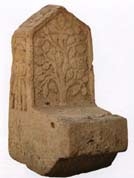Web catalog
Most read
Most read last 7 days
Most Discussed
Top rated
Statistics
- Total registered users: 10026
- Total articles: 23656
- Total comments: 2087
- Last entry: Kebo presenting evidence that Izetbegovic brought mujahideen to Bosnia
- Last update: 11.01.2019. 23:44
GOTHIC ARCHITECTURE
Written 03.12.2009. 10:49
 Once a Dominican church of St.Anthony\'s, and nowadays mosque Fethija in Bihac, is the oldest edifice of Gothic style on the territory that Bosnia and Herzegovina covers today. The church was built around 1266 as the village gained rank of the free royal city (1262). The church of St. Nicholas in Mile near Visoko was in the forties of the 14th century constructed upon the ruins of the above mentioned Romanesque edifice. The building contained a wide square space intended for worshippers and an elongated choir stalls with trilateral end pointing towards East.The corners were reinforced with counterphore and windows with pointed apses were perforated with stone lace. Great deal of churches had a rectangular choir-stalls: the church of St. Mary in Srebrenica, Zvornik, Olovo,Jajce,the church of St. Catherine in Kresevo and the church of St. Gregory in Kraljeva Sutjeska. They all belonged to the same type called preaching churches and according to regulations of the order they were all modestly equipped. Close connections with Dalmatia are visible on the monuments in Jajce; the parts of richly sculptured Phial from the church of St. Mary can be ascribed to the Bonino Circle from Milan (1429), and an unknown edifice on the fortress was adorned in a manner resembling to the work of Andrija Alesi (1430 - 1504).
Once a Dominican church of St.Anthony\'s, and nowadays mosque Fethija in Bihac, is the oldest edifice of Gothic style on the territory that Bosnia and Herzegovina covers today. The church was built around 1266 as the village gained rank of the free royal city (1262). The church of St. Nicholas in Mile near Visoko was in the forties of the 14th century constructed upon the ruins of the above mentioned Romanesque edifice. The building contained a wide square space intended for worshippers and an elongated choir stalls with trilateral end pointing towards East.The corners were reinforced with counterphore and windows with pointed apses were perforated with stone lace. Great deal of churches had a rectangular choir-stalls: the church of St. Mary in Srebrenica, Zvornik, Olovo,Jajce,the church of St. Catherine in Kresevo and the church of St. Gregory in Kraljeva Sutjeska. They all belonged to the same type called preaching churches and according to regulations of the order they were all modestly equipped. Close connections with Dalmatia are visible on the monuments in Jajce; the parts of richly sculptured Phial from the church of St. Mary can be ascribed to the Bonino Circle from Milan (1429), and an unknown edifice on the fortress was adorned in a manner resembling to the work of Andrija Alesi (1430 - 1504).The tower of Saint Luke is characteristic for a blend of specifically Bosnian and Dalmatian traditionalism. It was constructed between 1461. and 1463. as an edifice with Romanesque gabarit although a Gothic window in the first floor together with sharp arch roofs in interior reveal its true identity. The tower is in fact the sole original medieval tower in the interior of the Balkan peninsula.
Considering the secular architecture there were two significant royal residencies: Bobovac and Jajce. There is a direct influence of Hungarian court art from the 14th and 15th century, obvious in the equipment of Bobovac while the court in Jajce was constructed in forms of Dalmatian - Venetian late Gothic architecture. The so called soft style of Parler school(1400) is visible on a few objects in Bobovac, and sepulchral slabs of Bosnian monarchs from the court chapel belong to extraordinary beautiful monuments.
A great deal of monuments pertaining to fine arts and artistic crafts is saved on the territory of Bosnia and Herzegovina. The majority of the works of art is guarded in Franciscan monasteries of Kraljeva Sutjeska, Kresevo and Fojnica. The rich and renowned inventory of the monasteries in Srebrenica, Zvornik, Olovo and Visoko was irretrievably destroyed during the Viennese War, 1683. - 1699., and the treasury of Kresevo monastery was substantially damaged in the fire in 1765.
A part of Gothic wing is altar containing the painting "Deputation of the Kings" on one side and "Christ\\\\\\\'s pains" on another level surface. The first side belongs to the joyous cycle and was intended for occasions when the altar was open, and the second part pertains to the mournful cycle when the wings were closed. Master and creator of collapsible altar originate from same school from south-eastern Europe, possibly from Styria and it is possible to date it in the early 15th century. A beautiful silver chalice is also a part of the same treasury from the second half of 14th or early 15th century. A part of silver chalice adorned with engraving from Kresevo - although it is missing its original cup- appears to be from the same period. The silver pacifical in Kresevo is interesting for its engraving medallions in the ends of arms, representing persons dressed typically for the 15th century. Silver and gold-plated custodia reveals late Gothic elements together with silver censer from the same treasury. A late Gothic gold and slender monstranza that was guarded in the treasury of monastery on Scito in Rama was destroyed in fire during the Second World War. Only photography has been saved.
Casula representing Crucifiction, St.Mary and St.John in Sutjeska\\\\\\\'s treasury resembles to Dalmatian embroidery of the 15th century. Corpus Christi is formed in a typical Gothic style: breaking posture of the body at the foot of the cross and characteristically wrinkled clothes ( partially lately unskilfully restored ) represents an exeptionally worthy example of medieval embroidery.
It is possible to date only one part of great deal of chalices of late Gothic style in Kraljeva Sutjeska, Fojnica and Kresevo to the 15th century while the second part is closer to 16th and even to the begining of 17th century.
Only a lower part of the great stone cross with Jesus\'s legs riveted to one another carved in naturalist manner with joint characeristic to Gothic art and later styles. On the panel of widened pedestal there are two persons shown in high relief: the left person is bigger and dressed in richly seamed gown tightened closely in waist and with open cape thrown over. The second figure is clothed the same only an object similar to bag hanging on a band attached to belt is different. The figure holds the Holy Grail in the right hand while in the left hand there is an open coil-possibly Gospel. According to iconographic regulations the figures represented are St. Mary and St. John. The clothes realistically depicted resemble to clothing style common in the late Middle Ages or to be more precise in last decades of the 15th century, so the spirit of early Renaissance is already felt. A bronze bucket from Kraljeva Sutjeska found in Bobovac belongs to the same period and with its adornments reminds of Korvin\'s Renaissance.
ILLUMINATED MANUSCRIPTS
Divos\\\'s Gospel from the first decades of 14th ct. stands out among few manuscripts whose illuminators were educated on the West. The Venetian Apocalypse - a magnificent manuscript in which little flags have as separate ornamental motifs Kotromanic crowns and Angevine lilies. There are two exceptionally valuable manuscripts: Hval\'s Miscellany and Hrvoje\'s Missal. Both of the manuscripts were written in Croatian coastal town of Split, on order from Duke of the Lower parts and the Count of Split, the most powerful Bosnian nobleman Hrvoje Vukcic Hrvatinic.
Hval\\\'s Miscellany is written in Croatian Cyrillic script on 353 parchment papers, composed in 1404 in Split by the hand of the Krstjanin/Bosnian Church Christian named Hval. The codex contains parts of the Bible, some apocryphal songs and smaller theological discussions. It is very richly adorned with miniatures,flags, initials, separate figures, titles and portraits.The two illuminators shaped the Codex. The one that created figures of Apostles with Jesus, Crucifiction and Our Holy Mother on throne as well as initials containing human figures and some ornaments uses blue basis with some gold on frames and dresses. Faces of the figures are purple-pink with rather red cheeks while the contours of the figures and drapery are lined in black. The artist is obviously under strong influence of Gothic easel art. The second artist is a typical miniaturist. The figures he painted are set on gold background and put into architectural frame. Complexion of the figures painted is pink and hair is red. This master is, judging from his style, a typical representative of Dalmatian Gothic school of the 15th century.
Hrvoje\'s Missal is more luxurious than Hval\\\'s Miscellany. It is written in Glagolitic script between 1405. and 1407. for St.Michael\\\'s church in Split( or Omis ). Glagolitic priest Butko wrote it on 247 parchment papers. The Missal is illustrated by the before mentioned illuminator of Hval\\\'s Miscellany who reveals himself more explicitly as a student belonging to same Tuscan Gothic workshop of late 14th century. He is the author of months\\\'s allegory, symbolical representations at the beginning of texts about Christ\\\'s pains and the saints figures.
Initials are adorned with foliate tendrils and with apostles\'s heads as well as with the head of Jesus. The pictures are made vividly in red green and blue color with gliding of some places. Drawings are very clear, and the figure movements are quite natural. St. Mark\'s lion is particularly conspicuous among symbols of evangelists, while St. John\'s head is depicted realistically - the characteristic of Florentine school. Donor Hrvoje is represented riding a horse on the whole page, equipped in manner of Italian knights of the 14th century.
























































 Kontaktirajte nas
Kontaktirajte nas
No comments